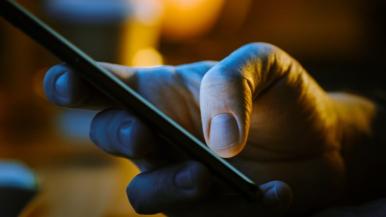Americans love technology, and they use a lot of it.
In the United States, the average person sends more than 40 emails daily and spends more than 38 hours each week on their smartphone, including around 23 hours a week texting. The average gamer (age 13 or older) spends nearly 6.5 hours a week playing video games.
In short, we give our hands, arms and elbows a workout without even realizing it. And like more athletic activities, repetitive keystrokes and mouse clicks may put us at risk for injury or aggravate existing conditions.
Little research has been done on the relationship between repetitive stress injuries — which occur when we repeat the same action to the extent that it strains our bodies — and the devices that now fill our lives.
But Robert Wysocki, MD, a hand, wrist and elbow surgeon at Rush, says many Rush patients have noticed that other joint or tendon problems seem to have developed or worsened after repetitive smartphone or computer use. Fortunately, many of these conditions are highly treatable.
Texting thumb
"What people call 'texting thumb' is not a clearly defined condition, but it usually refers to one of two things," Wysocki says.
Trigger thumb
The first of these things is trigger thumb, the constriction of a flexor tendon in the thumb, may result from repetitive gripping motions such as texting or holding a smartphone. Its symptoms include painful popping or snapping when the thumb bends and straightens; sometimes the thumb even becomes locked in a curled position.
Treatment for trigger thumb
Thanks to effective treatments, it doesn't have to stay that way. For patients with trigger thumb, Wysocki and his colleagues most commonly use cortisone injections, which eliminate pain and restore full mobility 80 to 85 percent of the time. In more severe cases, a brief surgical procedure may be required to release the pulley at the base of the thumb so that the tendon can move more easily.
If you have thumb pain or stiffness that seems to worsen with use of a smartphone, Wysocki recommends changing the way you use the device. For example, hold your phone with the hand you use less frequently or type messages with your index finger to give your thumbs a rest.
Thumb arthritis
Arthritis of the carpometacarpal joint, where the thumb connects to the wrist, is the other condition sometimes called texting thumb. Doctors don't yet know whether smartphone use can cause the condition.
But forceful pinching motions — such as gripping your phone or texting with your thumbs — may lead to more severe symptoms.
While this condition cannot be cured, a combination of rest and treatment can help most patients alleviate their pain and restore some of their ability to move.
Treatment for thumb arthritis
Treatments include splints and cortisone shots. Patients whose symptoms persist might need a procedure called a thumb carpometacarpal arthroplasty, in which a surgeon removes part or all of the arthritic trapezium bone to relive pain and improve function.
These conditions rarely occur in children. But it's never too early to use techniques to avoid repetitive stress injuries.
Cubital tunnel syndrome
Thumbs aren't the only joints to bear the brunt of technology.
Elbows can suffer as well if you spend too much time holding a phone to your ear, resting your elbow on a desk, or keeping your arm bent at an acute angle to use a computer mouse.
These positions can contribute to cubital tunnel syndrome, or increased tension in the tunnel through which the ulnar nerve passes in the elbow.
Relieving symptoms of cubital tunnel syndrome
The symptoms of cubital tunnel syndrome include numbness and tingling in the ring and small finger and soreness in the inside of the elbow or forearm.
To relieve these problems, Wysocki recommends avoiding pressure on the back of the elbow or using padding if you need to rest it on a hard surface. It's also important to avoid positions that keep your elbow flexed for long periods of time. It can also help to sleep in a splint that keeps your elbows from bending too much.
During the day, avoid positions that keep your elbow flexed for long periods of time. For example, use a hands-free device instead of holding the phone to your ear and move away from the computer so that your elbows are straighter as you type.
Many of these changes can alleviate cubital tunnel syndrome. In more severe cases, a simple outpatient surgery that takes the pressure off the nerve can greatly improve symptoms and help prevent the risk of permanent nerve damage to the hand.
Like trigger thumb and carpometacarpal arthritis, cubital tunnel syndrome largely affects patients in their 30s or older.
"These conditions rarely occur in children," Wysocki says. "But it's never too early to use techniques to avoid repetitive stress injuries."
Practical prevention tips
Want to prevent future problems? Here are a few ideas for both adults and children:
- Get some thumb rest. Use your forefinger to text or try the voice feature on your phone to send messages.
- Stretch. Open and close your fingers throughout the day to keep your tendons nimble. Wrist circles can also help.
- Call, don't text. Try chatting rather than texting or emailing.
- Track your smart phone usage and think of ways you can cut back. Consider what's important and what isn't. For example, if you find yourself spending more time with your phone than your family and it bothers you, start putting away the phone during dinner and enjoy some face-to-face conversations with your loved ones.




